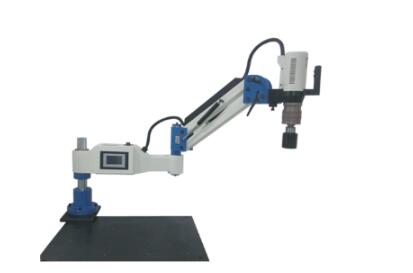Many people may have encountered the problem of broken taps of tapping machines, but few can accurately find the source of the problem. Generally speaking, there are roughly 12 types of reasons for the breaking of equipment taps. Let’s take a closer look:
1. Improper tapping steps
When tapping high-hardness tapping parts or deep holes, tap tapping in grades to avoid one-step tapping.
2. The feed speed is too fast, resulting in excessive torque. When processing threads with ordinary taps, it is recommended that the speed of the tapping machine should not exceed 100 rpm.
3. Improper operation
When machining blind hole threads, when the tap is about to touch the bottom of the hole, the operator does not realize that the tap is still feeding at the tapping speed when the tap is not at the bottom of the hole, or the tap breaks when the chip removal is not smooth. It is recommended that operators strengthen their sense of responsibility.
4. The cutting fluid is not used or selected improperly. A large amount of heat is generated when tapping, especially for some non-ferrous metals with strong ductility, a targeted selection of cutting fluid is required.
5. Insufficient concentricity
At the beginning of tapping, the starting position of the tap is incorrect, that is, the axis of the tap is not concentric with the center line of the bottom hole, and the torque is too large during the tapping process, which is the main reason for the tap to break.
6. The material problem of the attack piece
The material of the tapping part is impure, and there are hard spots or pores locally, causing the tap to lose balance and break instantly.
7. The bottom hole diameter does not match the tap
For example, when processing the M50.5 thread of ferrous metal material, the selected 4.5 mm drill should be used to make the bottom hole of the cutting tap. If the 4.2 mm drill is used to drill the bottom hole by mistake, the cutting part required by the tap during tapping will inevitably increase, and then the tap will be broken. It is recommended to select the correct bottom hole diameter according to the type of tap and the material of the tapping piece. If you don’t have a fully compatible drill bit, you can choose a larger one.
8. Poor tap welding
Especially for large taps, in order to save expensive high-speed steel, many manufacturers use friction butt welding, using 45 steel and high-speed steel for the shank and edge of the tap. A large number of tap breaks are caused by weak welding. The welding quality of taps is mainly determined by welding friction pressure, friction time, upsetting pressure and upsetting time.
In the friction stage, harmful impurities such as low melting point compounds on the contact surface of 45 steel and high speed steel should be squeezed, and finally squeezed together under appropriate upsetting pressure. When welding, because 45 steel has low strength at high temperature, it will produce great compression deformation, forming a large flanging under friction pressure, and high-speed steel has sufficient strength and small flanging, making the high-speed steel to be welded. The low melting point compound is not completely extruded, and it is easy to crack after welding, causing the tap to break during use. In addition, if the stress is not released in time after welding, it is easy to break in the heat-affected zone
9. The effective cross-sectional area of the tap is too small, which leads to too large bearing capacity per unit cross-sectional area, and breaks when the strength limit of the tap is exceeded.
10. Excessive size difference at the transition part of the tap section or no design transition fillet will result in stress concentration, and it is easy to break at the stress concentration point during use. The transition section of the cross section at the connection between the tool holder and the blade is too close to the joint, resulting in the superposition of complex welding stress and stress concentration in the transition section of the cross section, resulting in a large stress concentration, and causing the tap to break during use.
11. Incorrect selection of taps for high-quality taps, such as cobalt-containing taps, cemented carbide taps, coated taps, etc. Parts with too high hardness should be selected for tapping.
12. Improper heat treatment process
In the heat treatment process of the tap, if the tap is not preheated before quenching, overheated or burned after quenching, tempered in time and prematurely cleaned, cracks may occur.



